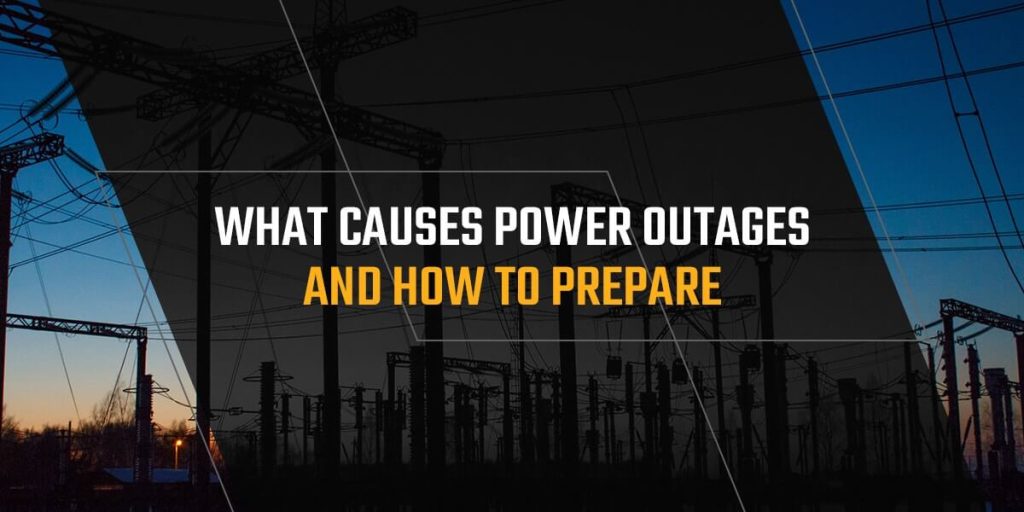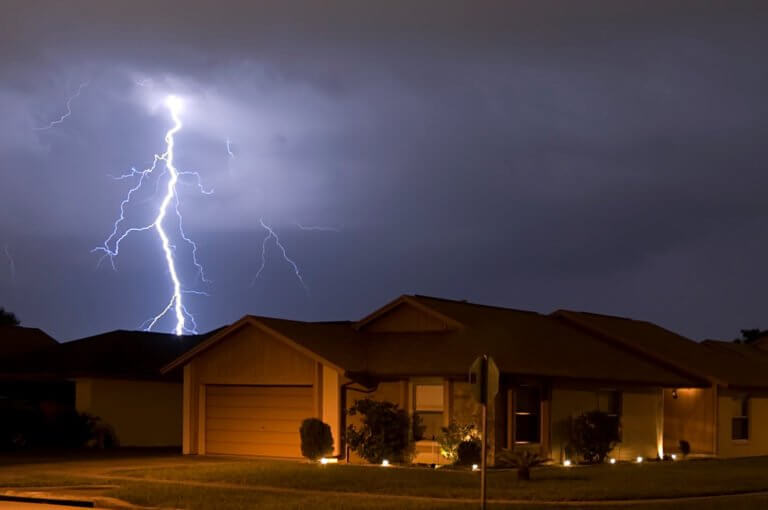Causes of Whole-House Power Outages and How to Remedy Them

Experiencing a complete power outage in your home can be frustrating and inconvenient. Understanding the causes of power outages and how to address them is crucial for ensuring safety and convenience. Below is a detailed guide on the causes of whole-house power outages and how to remedy them:
I. General Power Grid Failure:
`General Power Grid Failure
A general power grid failure, often referred to as a blackout or total power outage, is a significant disruption of electricity supply across a wide area, affecting many households and businesses. Understanding the causes and solutions to such a failure is essential for preparedness and response. In this section, we will explore the common causes of general power grid failures and strategies to deal with them.
Causes:
a. Severe Weather Events:
- Cause: Extreme weather conditions, such as hurricanes, thunderstorms, or ice storms, can damage power infrastructure, leading to widespread outages.
- Effects: Long-lasting and widespread power outages affecting entire communities.
b. Equipment Failures:
- Cause: Critical equipment failures within the power grid, such as transformers or substations, can disrupt electricity supply.
- Effects: Sudden and large-scale power outages, with widespread impact.
c. Cyberattacks and Sabotage:
- Cause: Malicious cyberattacks or sabotage of power grid infrastructure can cripple the system and disrupt electricity supply.
- Effects: Deliberate and potentially long-lasting power outages with the potential for broader consequences.
d. Grid Overloads:
- Cause: Overloading of the grid due to excessive electricity demand or inadequate capacity can lead to system failures.
- Effects: Widespread and sustained power outages affecting entire regions.
e. Faulty Grid Management:
- Cause: Inefficient grid management or operational errors can lead to grid instability and failures.
- Effects: Sudden power outages that can take time to rectify.
Solutions:
1. Emergency Preparedness:
- Create an emergency kit that includes flashlights, batteries, portable chargers, non-perishable food, and water to be prepared for prolonged outages.
2. Backup Power Sources:
- Consider investing in backup power sources, such as generators or uninterruptible power supplies (UPS), to maintain essential appliances during a power outage.
3. Community Support:
- Collaborate with neighbors and local community groups to share resources and support one another during grid failures.
4. Reporting Outages:
- Promptly report power outages to your utility provider to help them assess the situation and prioritize restoration efforts.
5. Grid Resilience:
- Advocate for and support grid resilience initiatives to reduce the impact of grid failures and enhance recovery.
6. Cybersecurity Measures:
- Support and engage in cybersecurity measures to protect the power grid from cyberattacks and potential sabotage.
7. Disaster Preparedness Plans:
- Develop and communicate disaster preparedness plans with your family and community to ensure a coordinated response during power grid failures.
A general power grid failure is a significant disruption that can impact daily life, safety, and communication across entire regions. Emergency preparedness, backup power sources, and community support play essential roles in coping with these events. Advocating for grid resilience and supporting cybersecurity measures is also critical in preventing future grid failures. It’s vital to stay informed, collaborate with local authorities, and be ready to act during these challenging times.
II. Electrical Overload:

Causes:
Electrical overload, often referred to as overloading the electrical circuit, occurs when the power demand from electrical appliances and devices exceeds the capacity of the electrical system. This excessive electrical load can lead to circuit breakers or fuses tripping, causing a power outage throughout the house. There are several common causes of electrical overload:
a. Excessive Device Usage:
- Cause: Running too many high-power devices simultaneously, such as air conditioners, space heaters, and kitchen appliances, can strain the electrical system.
- Effects: Overloads can lead to overheating, circuit damage, and potential fire hazards.
b. Old Wiring and Circuits:
- Cause: Older homes may have outdated electrical wiring and circuits that are ill-equipped to handle the power requirements of modern appliances.
- Effects: These older systems are more susceptible to overloads and can pose safety risks.
c. Faulty Wiring:
- Cause: Faulty or damaged electrical wiring can increase the risk of overloads. Loose connections or exposed wires can lead to short circuits and electrical fires.
- Effects: Faulty wiring is hazardous and requires immediate attention.
d. Lack of Dedicated Circuits:
- Cause: Overloading may occur when multiple heavy-load devices share a single circuit. For instance, plugging in a microwave, refrigerator, and dishwasher on the same circuit can lead to overloading.
- Effects: This can trip the circuit and result in power outages.
e. DIY Electrical Work:
- Cause: Poorly executed do-it-yourself (DIY) electrical work may lead to circuit overloads. Incorrectly wired outlets, switches, or fixtures can stress the electrical system.
- Effects: DIY mistakes can cause short circuits and electrical malfunctions.
Remedies:
Addressing electrical overload issues involves both prevention and corrective actions. Here are steps to remedy the problem:
1. Energy-Efficient Appliances:
- Invest in energy-efficient appliances and devices. These consume less power, reducing the risk of overloads.
2. Load Distribution:
- Distribute the power demand evenly across circuits by avoiding the simultaneous use of high-wattage appliances on the same circuit.
3. Circuit Upgrades:
- Consider upgrading your electrical circuits, especially if you live in an older home with outdated wiring. Newer circuits are designed to handle increased loads safely.
4. Professional Inspection:
- Hire a qualified electrician to inspect your electrical system. They can identify and rectify any issues, ensuring the system’s safety and efficiency.
5. Electrical Panel Upgrade:
- If your electrical panel is outdated and unable to handle modern power demands, consider upgrading it to a larger capacity.
6. Avoid DIY Electrical Work:
- Unless you are a trained electrician, avoid DIY electrical work. Hire a professional for installations and repairs.
7. Use Surge Protectors:
- Install surge protectors on sensitive electronic devices to safeguard them from power surges and overloads.
Dealing with electrical overload is crucial for the safety and functionality of your home. Preventive measures, regular maintenance, and professional guidance will help you avoid overloading your electrical circuits and experiencing frustrating power outages. If you suspect an electrical overload, consult a licensed electrician for a thorough inspection and necessary repairs.
III. Home Electrical System Malfunction

Home electrical system malfunctions can occur due to various reasons, ranging from simple short circuits to complex equipment failures. Understanding the causes and knowing how to address them is essential to maintain a safe and operational electrical system. Below, we will discuss some common causes of home electrical system malfunctions and how to remedy them:
a. Short Circuits:
- Cause: Short circuits happen when electrical wires cross or come into close contact. This can result from cable damage, equipment faults, or design flaws.
- Symptoms: Causes electrical disturbances, such as power cut-offs and can be challenging to troubleshoot.
b. Circuit Malfunction:
- Cause: Malfunctions in the electrical circuit, electrical panel, or other electrical devices can be a source of trouble.
- Symptoms: Devices not working, damaged switches, or tripped circuit breakers.
c. Faulty Power Inverter:
- Cause: A malfunctioning power inverter can lead to an incorrect or disrupted power conversion.
- Symptoms: Inconsistent power conversion, causing equipment malfunction.
d. Electrical Component Failures:
- Cause: Failures within electrical components like motors, control units, or sensors can be a reason for malfunctions.
- Symptoms: Devices not functioning correctly, unusual noises, or erratic behavior.
e. Interrupted Power Supply:
- Cause: Power interruptions, like disconnecting circuit breakers or breaking the circuit, are safety measures. If not executed correctly, they can lead to electrical disruptions.
- Symptoms: Devices not working, or circuits repeatedly tripping.
f. Wire Damage:
- Cause: Electrical wire damage or breakage due to environmental factors, mechanical issues, or aging can disrupt the electrical flow.
- Symptoms: Power loss at wire connection points or frequent circuit breaker trips.
g. Socket and Outlet Issues:
- Cause: Faulty plugs or sockets can lead to issues when devices can’t connect or plug in correctly.
- Symptoms: Devices not working when plugged in or immediate power loss upon connection.
Remedies:
Addressing home electrical system malfunctions involves proper diagnosis and repair procedures. Here are steps to remedy these problems:
1. Power Off:
- In the event of a malfunction, turn off the power to ensure safety.
2. Call an Electrician:
- Contact a professional electrician to inspect and repair the electrical system.
3. Check the Electrical Panel:
- Examine the electrical panel to identify any tripped circuit breakers and malfunctioning devices.
4. Replace Faulty Equipment:
- Replace malfunctioning or damaged electrical devices.
5. Electrical Repairs:
- Use electrical repair techniques and replace faulty components.
6. Electrical Safety:
- Ensure all electrical repair and maintenance work is performed safely and in compliance with regulations.
A deep understanding of the causes and solutions for home electrical system malfunctions can help you maintain a safe and smoothly functioning electrical system. However, always seek the assistance of a professional electrician to ensure the safety and reliability of your electrical system.
IV. Power Cut Due to Maintenance Work

Temporary power cuts due to maintenance work are a common occurrence in residential electrical systems. Whether it’s routine maintenance or more extensive repairs, understanding the reasons behind these interruptions and how to manage them is essential for homeowners. In this section, we will delve into the causes and solutions related to power cuts during maintenance work:
Causes:
a. Scheduled Maintenance:
- Cause: Scheduled maintenance is planned by utility companies to perform routine checks, repairs, and upgrades to ensure the electrical system’s reliability.
- Effects: Temporary power cuts are usually notified in advance, but they can disrupt your daily activities.
b. Emergency Repairs:
- Cause: Unforeseen problems, such as equipment failures or damage due to weather events, may necessitate emergency repairs that lead to power cuts.
- Effects: Emergency repairs are typically unplanned and can lead to unexpected outages.
c. Upgrades and Expansion:
- Cause: To accommodate growing electrical demands, utility companies may undertake upgrades or expansion projects that require power cuts.
- Effects: While these improvements are for the long-term benefit, they can cause temporary inconveniences.
d. Substation Maintenance:
- Cause: Maintenance of electrical substations is crucial for ensuring stable power supply. However, it may require power interruptions.
- Effects: Planned substation maintenance can result in power cuts within a specific area.
Solutions:
1. Stay Informed:
- Utility companies usually provide information about scheduled maintenance and power cuts. Stay informed through their communication channels and plan accordingly.
2. Emergency Preparedness:
- Be prepared for unexpected power cuts due to emergency repairs. Have backup power sources like generators or uninterruptible power supplies (UPS) for essential devices.
3. Plan Your Activities:
- If you know in advance about scheduled maintenance, plan your activities around the outage period to minimize disruptions.
4. Report Outages:
- If you experience an outage that hasn’t been scheduled or communicated, report it to your utility company for immediate attention.
5. Backup Systems:
- Invest in backup systems like generators or solar power solutions to provide electricity during power cuts, especially for critical systems like medical equipment.
6. Battery Backup:
- Use battery backup systems for devices like computers and internet routers to keep them operational during short outages.
7. Battery-Powered Lights:
- Keep battery-powered flashlights or lanterns handy for lighting during power cuts, ensuring safety and convenience.
8. Update Contact Information:
- Ensure your contact information is up to date with your utility provider to receive outage notifications and updates.
9. Collaborate with Neighbors:
- Coordinate with your neighbors during extended outages to share resources and support each other.
Temporary power cuts due to maintenance work, whether scheduled or unplanned, are a part of maintaining a reliable electrical system. While they can be inconvenient, understanding the causes and being prepared for such interruptions will help you navigate them more effectively. Stay informed, plan ahead, and consider backup power sources to minimize disruptions during power cuts related to maintenance work.
V. Power Outages Caused by Severe Weather

Severe weather conditions can be a major cause of power outages in residential areas. These weather-related outages can range from minor inconveniences to more prolonged and widespread disruptions. In this section, we’ll explore the various aspects of power outages caused by severe weather and how to deal with them.
Causes:
a. Lightning Strikes:
- Cause: Lightning strikes are a common cause of power outages. When lightning directly strikes power lines, it can damage transformers, substations, and power distribution equipment.
- Effects: Outages caused by lightning strikes can be sudden and widespread, affecting numerous households.
b. High Winds:
- Cause: Strong winds can cause trees and branches to fall onto power lines, leading to electrical failures.
- Effects: Wind-induced outages can be unpredictable and may vary in their severity.
c. Ice and Snow Accumulation:
- Cause: Accumulated ice and snow can weigh down power lines and equipment, causing them to break or fail.
- Effects: Winter storms can lead to widespread power outages, particularly in areas with heavy snowfall.
d. Flooding and Hurricanes:
- Cause: Flooding from heavy rains or hurricanes can inundate electrical infrastructure and lead to power outages.
- Effects: Flooding-related outages can be long-lasting and challenging to address.
e. Tornadoes and Hail:
- Cause: Tornadoes and hail can physically damage power lines and equipment.
- Effects: Power outages caused by tornadoes or hailstorms can be localized but severe.
Solutions:
1. Emergency Kit:
- Prepare an emergency kit that includes flashlights, batteries, portable chargers, and non-perishable food and water.
2. Stay Informed:
- Stay informed about weather forecasts and warnings from local authorities. Knowing when severe weather is expected can help you prepare.
3. Backup Power:
- Consider investing in backup power sources such as generators or uninterruptible power supplies (UPS) for critical appliances.
4. Secure Outdoor Items:
- Before severe weather hits, secure outdoor items like lawn furniture and trash cans to prevent them from becoming projectiles during storms.
5. Trim Trees and Branches:
- Regularly trim and maintain trees near power lines to reduce the risk of branches falling and causing outages.
6. Report Outages:
- If you experience a power outage during or after severe weather, report it to your utility company so they can assess the situation.
7. Stay Safe:
- During severe weather events, prioritize your safety. Stay indoors, away from windows, and avoid using electrical appliances during thunderstorms.
8. Neighbors Helping Neighbors:
- Collaborate with your neighbors during extended outages to share resources and support one another.
Severe weather-related power outages are a common challenge that homeowners may face, especially in regions prone to adverse weather conditions. While these outages can be disruptive, preparation and awareness can help mitigate their impact. Having an emergency kit, staying informed, and considering backup power sources are essential strategies for coping with power outages caused by severe weather. Always prioritize safety and report outages to your utility provider for timely assistance.
VI. Electrical Equipment Failures
Failures of electrical equipment can disrupt the flow of electricity within your home, causing inconvenience and safety concerns. Identifying the causes and implementing effective solutions for these failures is essential to maintain a functional electrical system. In this section, we will explore common causes of electrical equipment failures and strategies to address them.
Causes:
a. Outdated or Damaged Outlets:
- Cause: Over time, electrical outlets can become outdated or damaged, leading to poor connections and potential hazards.
- Symptoms: Loose or non-functioning outlets, sparking, or blackened outlet plates.
b. Faulty Switches:
- Cause: Switches that control lighting or appliances can wear out, leading to difficulties in turning devices on or off.
- Symptoms: Switches that don’t respond, sparks, or flickering lights.
c. Malfunctioning Receptacles:
- Cause: Receptacles that don’t provide proper power can disrupt the operation of devices connected to them.
- Symptoms: Devices not working when plugged in, damaged cords, or power interruptions.
d. Tripped Circuit Breakers:
- Cause: Circuit breakers can trip due to overloads or short circuits, causing power interruptions.
- Symptoms: Sudden loss of power, often accompanied by a tripped breaker switch.
e. Faulty Appliances:
- Cause: Household appliances can malfunction and create electrical issues, posing a risk to your electrical system.
- Symptoms: Devices not working as expected, unusual sounds, or electrical odors.
f. Damaged Wiring:
- Cause: Damaged or frayed electrical wiring can compromise the safe flow of electricity.
- Symptoms: Dimming or flickering lights, sparking, or exposed wires.
Solutions:
1. Outlet and Switch Replacement:
- Replace outdated or damaged outlets, switches, and receptacles to ensure safe and reliable connections.
2. Regular Maintenance:
- Routinely inspect and maintain electrical equipment, including outlets, switches, and receptacles, to identify issues early and address them promptly.
3. Circuit Breaker Assessment:
- Regularly check the functionality of circuit breakers. Replace any that are no longer functioning as they should.
4. Appliance Safety:
- Inspect and maintain household appliances to ensure they operate safely and do not pose risks to your electrical system.
5. Professional Assistance:
- If you encounter electrical equipment failures beyond your capabilities, consult a professional electrician to diagnose and resolve the issues.
6. Circuit Testing:
- Periodically test electrical circuits for proper functioning, ensuring that all connections are secure and safe.
7. Wiring Inspection:
- Regularly inspect and maintain electrical wiring to identify and address potential hazards.
Electrical equipment failures can disrupt your daily life and pose safety risks within your home. Proper maintenance, inspection, and timely replacement of outdated or damaged equipment are key to preventing these issues. Always prioritize safety, and consult a professional electrician when dealing with complex electrical equipment failures beyond your expertise.